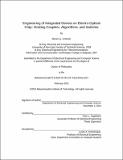| dc.contributor.advisor | Peter L. Hagelstein. | en_US |
| dc.contributor.author | Uros̆ević, Stevan Lj. | en_US |
| dc.contributor.other | Massachusetts Institute of Technology. Department of Electrical Engineering and Computer Science. | en_US |
| dc.date.accessioned | 2016-01-15T21:10:11Z | |
| dc.date.available | 2016-01-15T21:10:11Z | |
| dc.date.copyright | 2015 | en_US |
| dc.date.issued | 2015 | en_US |
| dc.identifier.uri | http://hdl.handle.net/1721.1/100878 | |
| dc.description | Thesis: Ph. D., Massachusetts Institute of Technology, Department of Electrical Engineering and Computer Science, 2015. | en_US |
| dc.description | Cataloged from PDF version of thesis. | en_US |
| dc.description | Includes bibliographical references (pages 192-202). | en_US |
| dc.description.abstract | The technology of modem purely electrical computers requires more electrical wiring for intra-chip and inter-chip communications as the number of cores increases. Consequently, energy consumption increases due to heat dissipation from low bandwidth electric wires. The conversion of electrical signals to optical signals has been proposed in the future electro-optical computers as a way of addressing this issue. Much work has gone into the design, fabrication, and testing of components of new optical elements that can be implemented in chips fabricated in unmodified CMOS processes. In this Ph.D. thesis advances are achieved through engineering of various integrated optical and electro-optical devices on the chip, algorithms for automatic engineering of integrated optical devices, and measurement methods that enable understanding of integrated device behavior. The highly unidirectional uniform optical grating couplers are simulated, and compared experimentally with typical uniform gratings on the same chip. Here, the method of comparison of devices in symmetrical structures is presented. An algorithm for the design of a grating that launches a beam with an arbitrary magnitude and flat phase front is described. As an extension of this, the second algorithm for the design of a grating that launches a beam (here, focusing) with an arbitrary magnitude and phase front is presented. An automatic algorithm which, from the 2D device contour file after optical proximity correction, builds up any 3D optical device further simulated in 3D-FDTD is described. The obtained device can be compared with the designed device before fabrication occurs. An electronically-controlled optical switch with free-carrier injection, which can switch digital optical signals from one waveguide into other, is described. This switch is many times smaller, faster and more energy efficient than a recent optical switch based on a traditional Mach-Zehnder interferometer. Next, three different measurement methods are presented and experimentally confirmed. The first method enables measurement of current through the heater in the complex diode topology on the chip. The second method is for measuring the desired temperature on the chip for tests of integrated devices. The third method is for automated measurement of angles of optical fibers for the coupling with the gratings. | en_US |
| dc.description.statementofresponsibility | by Stevan Lj. Uros̆ević. | en_US |
| dc.format.extent | 202 pages | en_US |
| dc.language.iso | eng | en_US |
| dc.publisher | Massachusetts Institute of Technology | en_US |
| dc.rights | M.I.T. theses are protected by copyright. They may be viewed from this source for any purpose, but reproduction or distribution in any format is prohibited without written permission. See provided URL for inquiries about permission. | en_US |
| dc.rights.uri | http://dspace.mit.edu/handle/1721.1/7582 | en_US |
| dc.subject | Electrical Engineering and Computer Science. | en_US |
| dc.title | Engineering of integrated devices on electro-optical chip: grating couplers, algorithms, and switches | en_US |
| dc.type | Thesis | en_US |
| dc.description.degree | Ph. D. | en_US |
| dc.contributor.department | Massachusetts Institute of Technology. Department of Electrical Engineering and Computer Science | en_US |
| dc.identifier.oclc | 933529462 | en_US |
